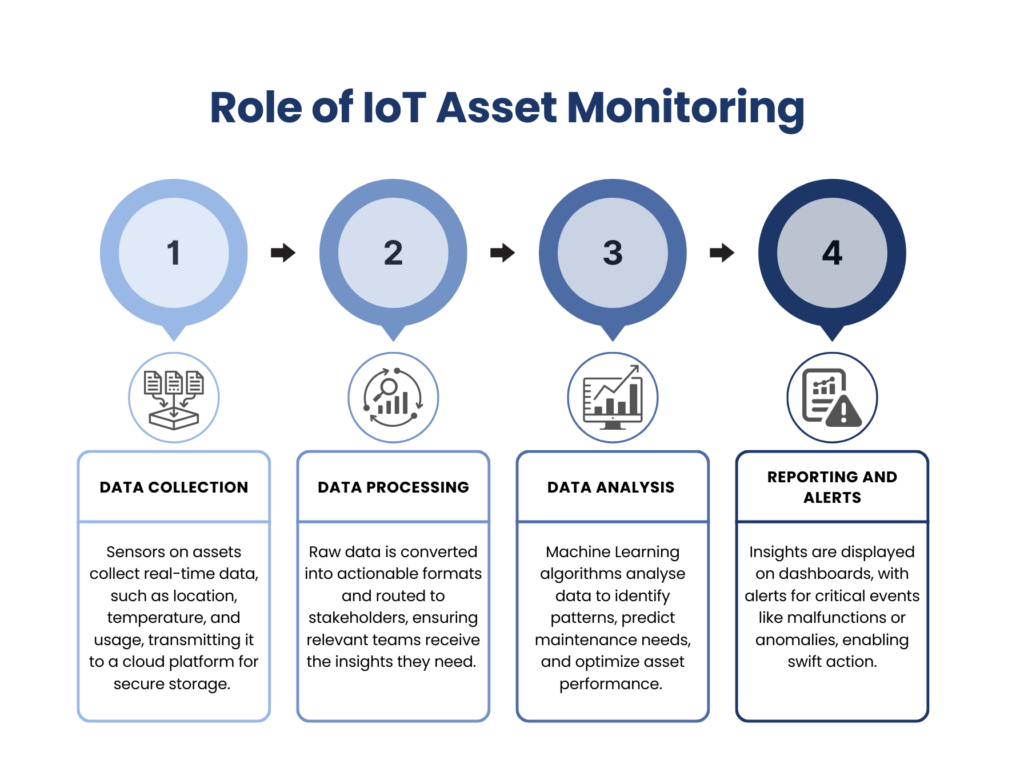The Internet of Things (IoT) has rapidly evolved from academic concepts to practical applications, revolutionizing industries such as manufacturing, mining, construction, and more. With its limitless potential for automation and digitization, IoT has become a cornerstone of modern asset monitoring. This transformation is driven by the availability of advanced sensors, cost-effective connectivity, scalable cloud platforms, big data processing, and intelligent machine learning (ML) tools, enabling organizations to monitor, manage, and optimize their assets like never before.
What is IoT Asset Monitoring and Asset Management?
IoT asset monitoring and management involves the use of Internet of Things (IoT) technology to track, manage, and maintain information about an organization’s physical assets, including machinery, devices, vehicles, and infrastructure. This monitoring applies to both movable and immovable assets, offering businesses real-time visibility and control over their operational resources.
Through IoT-enabled sensors and devices, data is continuously collected and transmitted for analysis. Advanced analytics tools process this data to provide actionable insights, helping organizations improve decision-making, optimize resource utilization, and enhance operational efficiency. From identifying potential equipment failures to tracking usage patterns, IoT asset monitoring empowers businesses to proactively manage their assets, reduce downtime, and drive productivity.
Impact of IoT on Asset Monitoring Work
IoT asset monitoring solutions empower industries to optimize operations, reduce costs, and drive business growth. IoT asset monitoring systems track, manage, and analyse physical assets which typically consist of three primary components:
Tracking Devices: Sensors and IoT devices, such as GPS trackers, temperature sensors, or smart locks, are deployed to monitor specific parameters of assets.
Connectivity: Communication channels like Wi-Fi, Bluetooth, cellular networks, or WLAN ensure real-time data transmission from devices to cloud-based platforms.
Software Applications: A central dashboard or app allows users to access processed data, monitor performance, and remotely manage connected devices.
Nowadays, there are multiple types of IoT devices used by businesses to record real-time data. The use of these devices completely varies on the needs of the enterprise, some of the commonly used devices are as follows:
GPS trackers
CCTV systems
Lighting controls
Smoke detectors
Carbon monoxide detectors
Bluetooth Low Energy transmitters
Smart locks
Temperature sensors
Role of IoT Asset Monitoring
IoT connects physical assets with IT systems, enabling seamless data exchange over the Internet through the following four steps:

Step 1: Data Collection
Sensors on assets collect real-time data, such as location, temperature, and usage, transmitting it to a cloud platform for secure storage.
Step 2: Data Processing
Raw data is converted into actionable formats and routed to stakeholders, ensuring relevant teams receive the insights they need.
Step 3: Data Analysis
Machine Learning algorithms analyse data to identify patterns, predict maintenance needs, and optimize asset performance.
Step 4: Reporting and Alerts
Insights are displayed on dashboards, with alerts for critical events like malfunctions or anomalies, enabling swift action.
Top Benefits of IoT in Asset Monitoring for Modern Businesses
Identifiable Growth Opportunities
With real-time visibility and condition tracking, IoT asset monitoring helps businesses reduce inefficiencies of cost and labour. Its data-driven approach enhances productivity and profitability across industries like manufacturing, retail, and logistics.
Real-Time Location Monitoring
IoT sensors like GPS and RFID provide precise asset tracking and improve asset allocation. Geofencing and alerts enhance security by swiftly addressing unauthorized movements or theft.
Efficient Utilization of Resources
IoT analyses past consumption patterns to optimize resource use and prevent shortages. Real-time condition monitoring enables predictive decisions, reducing downtime and boosting efficiency.
Warehouse Stock Management
IoT automates inventory tracking, ensuring accurate stock data and reducing errors. Automatic reordering based on real-time insights optimizes stock levels and enhances efficiency.
Smart Industrial Ecosystem
IoT connects assets for seamless information exchange, improving operational efficiency and decision-making. Its integration with AI and ML supports innovation and a scalable, interconnected industrial environment.
Agile Solutions for Productivity
Real-time asset insights allow businesses to optimize workflows and resource allocation. Agile strategies driven by IoT data boost productivity and adapt operations to changing demands.
Optimizing Asset Performance
Continuous monitoring detects anomalies, enabling proactive performance optimization. Predictive maintenance minimizes downtime, ensuring assets operate at peak efficiency.
Key IoT Use Cases of in Asset Monitoring
Some of the widely recognized IoT applications in asset monitoring include the following:
Water Treatment
IoT asset monitoring for water treatment plays a crucial role in the industry by tracking heavy water treatment machinery used in large manufacturing plants and industries. These machines require continuous monitoring of parameters such as chemical levels, odor, and corrosion. IoT-enabled devices conduct comprehensive site investigations, streamlining technicians’ tasks by providing timely alerts to ensure optimal performance and efficiency.
Logistics and Supply Chain
IoT in logistics asset monitoring optimizes the management of fleets and storage facilities. GPS trackers and environmental sensors monitor the location, temperature, and humidity of goods in transit. These systems send instant alerts for route deviations or environmental anomalies, ensuring goods are delivered on time and in optimal condition while reducing operational costs.
Energy and Utilities
IoT asset monitoring in the energy sector ensures the reliability of critical infrastructure, such as turbines, transformers, and pipelines. Sensors track parameters like temperature, pressure, and vibration in real time. Advanced analytics detect anomalies and predict maintenance needs, minimizing downtime and enhancing operational safety.
Healthcare Industry
IoT asset monitoring in the healthcare industry is utilised for tracking critical medical equipment such as ventilators, MRI machines, and infusion pumps. These devices require regular monitoring of usage patterns, maintenance schedules, and operational conditions. IoT-enabled systems provide real-time insights into equipment performance, alerting technicians to potential issues before they escalate, ensuring uninterrupted care and enhanced patient safety.
Transforming Water Management with Intelligent IoT Solutions
Stridely Solutions developed a Smart Water Quality System for a leading water treatment company to enable real-time monitoring and management of water quality.
Read the complete case study
Leverage IoT to Facilitate Enhance Asset Monitoring
Smart asset management powered by IoT brings transformative benefits, such as real-time monitoring, predictive maintenance, and enhanced operational efficiency. By integrating IoT, businesses can optimize asset value, reduce costs, and improve overall performance. Embrace the future of asset management with IoT-driven solutions.


